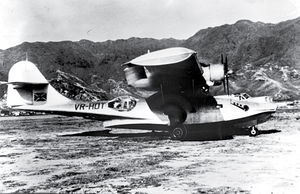VR-HDT
| VR-HDT - Vickers OA-10 | |
|---|---|
| VR-HDT | |

| |
| Model | Vickers OA-10 |
| Variation | Catalina 3 |
| Nickname | Miss Macao |
| Original owner | Foreign Liquidation Commission |
Contents
History
Cathay Pacific holds the dubious distinction of having suffered the world’s first mid-air hijacking. Of course that word hadn’t been invented in 1948 and this first incident of air piracy occurred for much the same reason as the piracies that had been the bane of Swire’s shipping fleet during the 1920s and 30s – the airline was carrying gold bullion.
Gold had long been a staple of business transactions on the China coast, where there was a mistrust of paper currency that was very understandable given the hyperinflation immediately preceding World War II. However, Britain was a signatory to the Bretton Woods agreement – the genesis of the IMF – and therefore restricted the free importation of gold, as did its colony, Hong Kong. Not so neighbouring Portuguese-owned Macau and so a lively and highly questionable import-export trade in gold bullion to Macau had grown up: not quite smuggling since it was openly carried on, but nevertheless exploiting a legal loophole.
Profits from the trade were large and the ever entrepreneurial Roy Farrell and Syd de Kantzow soon decided Cathay Pacific could benefit from a slice of this action. A spectacularly unsuccessful dummy-run, to see whether it was possible to land a DC-3 on the Macau racecourse, resulted in the aircraft belly-flopping in front of a grandstand packed with VIPs, minus its undercarriage. After this debacle, Syd and Roy went shopping in the Philippines for second-hand Vickers Catalina amphibious aircraft.
By 1948, Cathay Pacific had two of these seaplanes and was carrying out regular gold runs to Macau. How like Syd and Roy to see the potential earnings from carrying passengers on these 20-minute hops and to market them as ‘scenic flights’, but what a tragedy they did. On 16th July that year, four gangsters boarded one of the aircraft, known as Miss Macao, for the flight to Hong Kong. Their leader, Choi Tok, had been studying Cathay routine for months and had learned to fly Catalinas in Manila. Soon after take-off, the gang drew their weapons and Choi ordered the pilot, Captain Dale Cramer, to relinquish the controls of the aircraft. In an echo of earlier high-sea piracies, his plan was to fly the plane to the gang’s home village in the Pearl River Delta, offload the gold and ransom the passengers and crew. But it all went horribly wrong when Cramer refused to comply and Choi shot
him at point-blank range. As the pilot’s body slumped over the steering column, Miss Macao nose-dived into the sea, killing the remaining crew members, First Officer Ken McDuff and Flight Hostess Delca da Costa (who were engaged to be married), and 22 of the 23 passengers on board.
The survivor, Wong Yu, was swiftly identified by Macau police as a member of the pirate gang and his eventual confession told the tragic story of Miss Macao’s last flight. Wong himself slipped through the cracks in the judicial system because the Hong Kong Government considered they had no jurisdiction over a crime committed in Macau and the
Portuguese authorities took a similar position in view of the aircraft’s British status. Wong was released without charge, though legend has it that soon afterwards he was struck and killed by flying debris during a typhoon.
When Miss Macao went down, the ink was scarcely dry on Swire’s agreement to buy the majority shareholding in Cathay Pacific, but the decision had already been taken that the Macau gold run did not sit well with the firm’s reputation locally. “We do not feel disposed to have our name associated with the trade”, wrote Swire’s Hong Kong taipan, C.C. Roberts. “We would not like any such smell attached to us”.